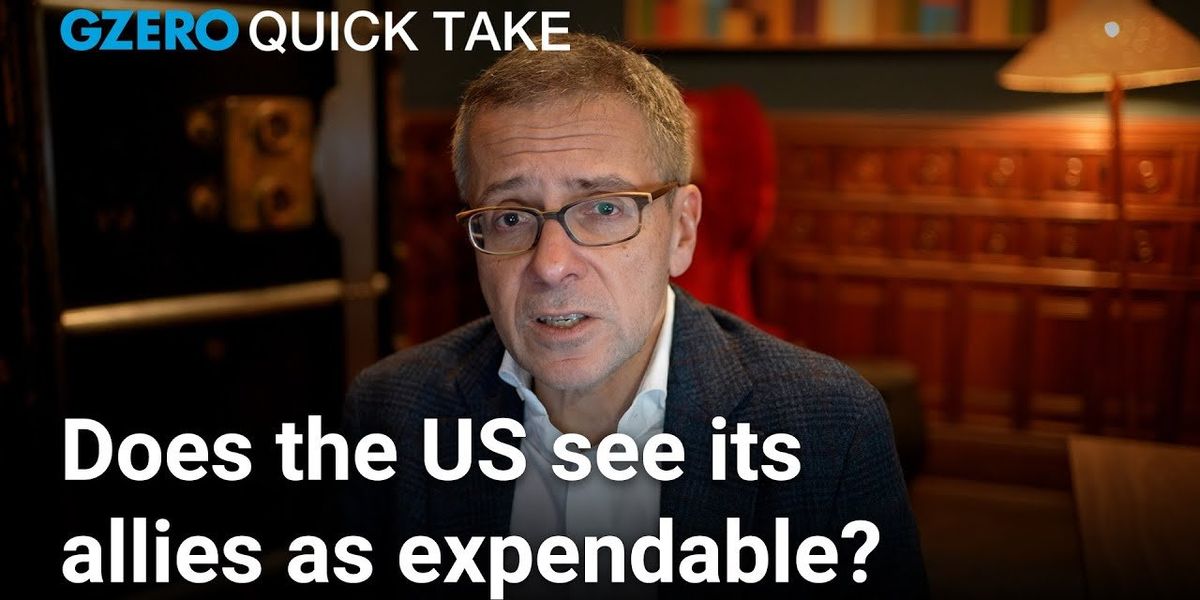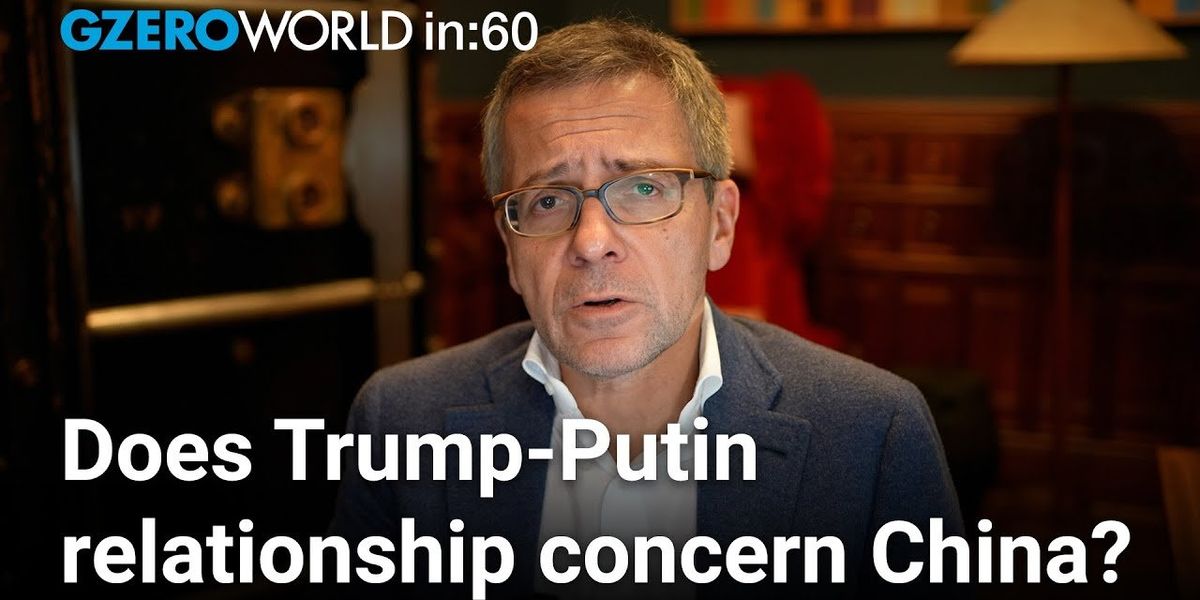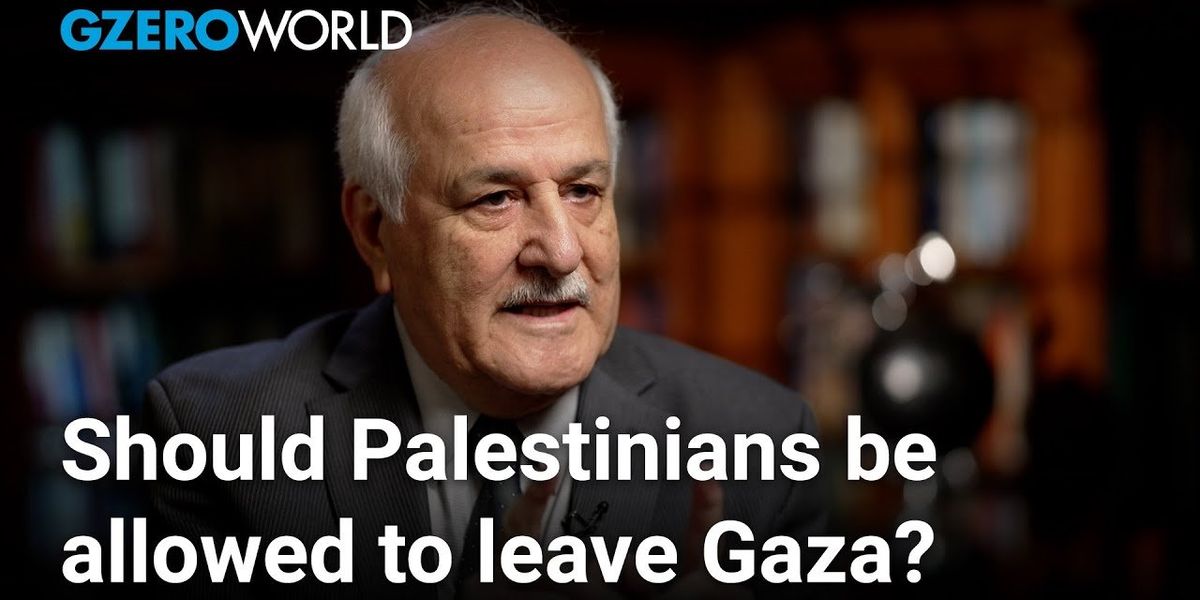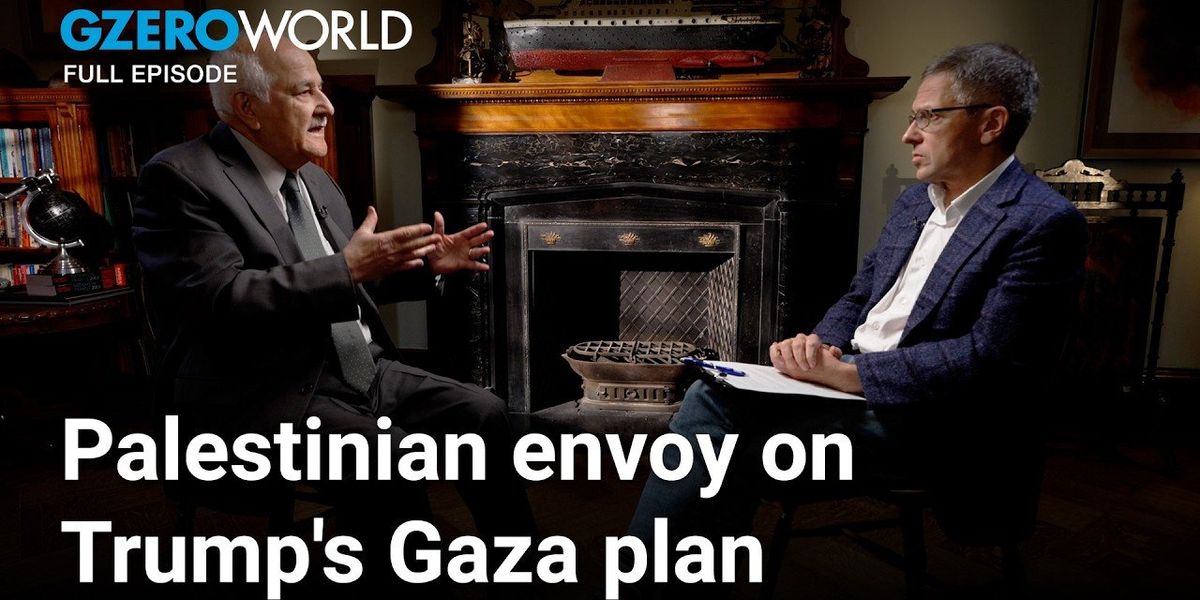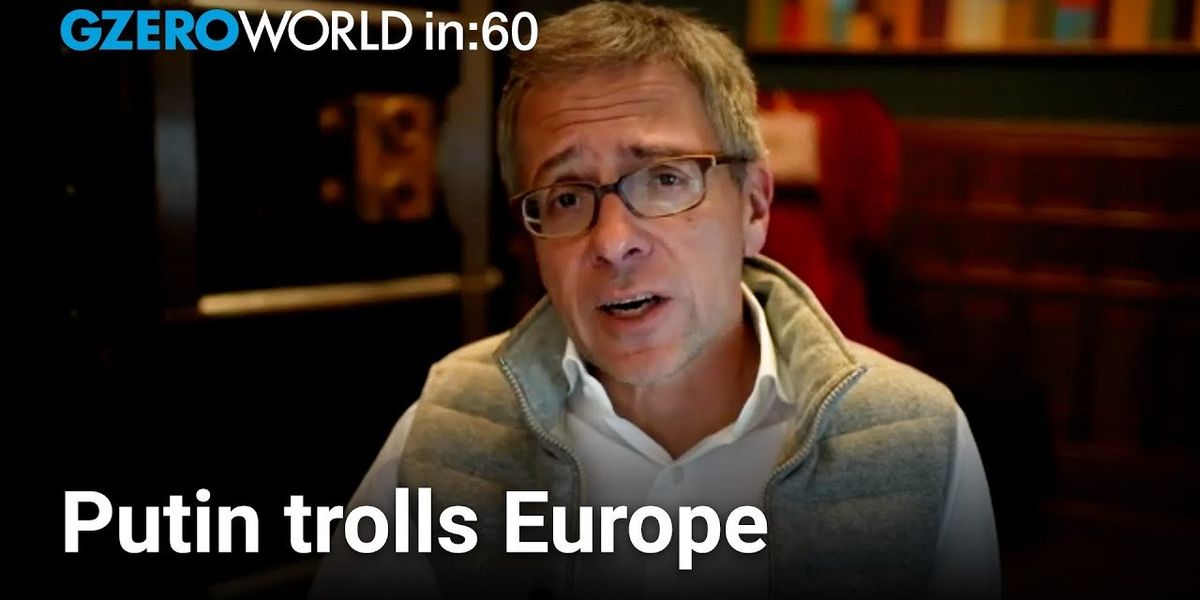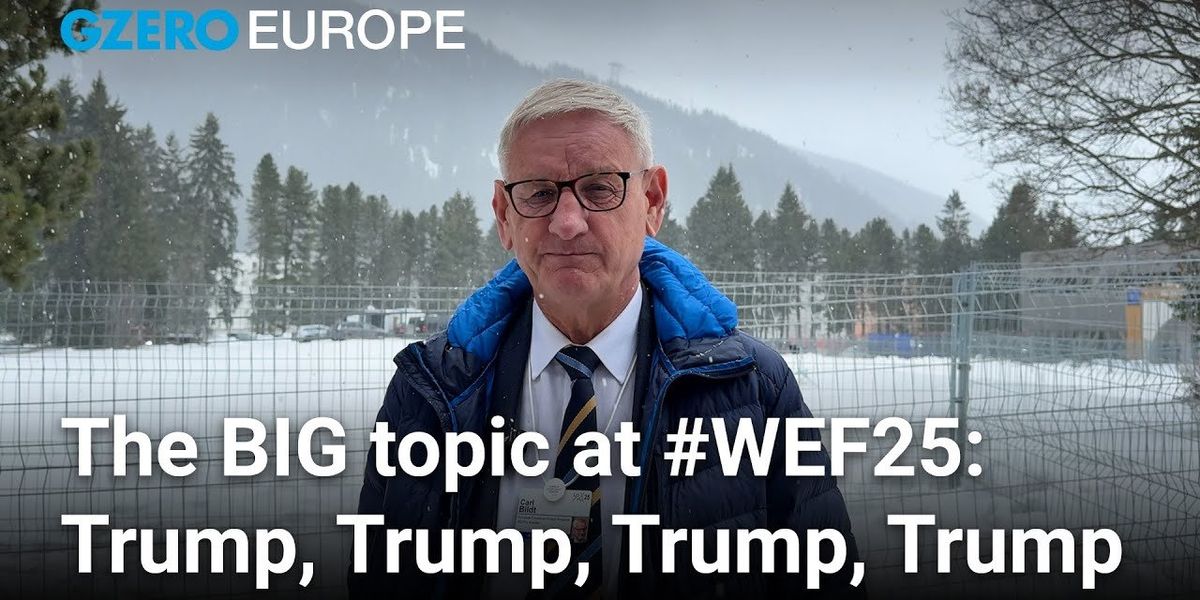Trending Now
We have updated our Privacy Policy and Terms of Use for Eurasia Group and its affiliates, including GZERO Media, to clarify the types of data we collect, how we collect it, how we use data and with whom we share data. By using our website you consent to our Terms and Conditions and Privacy Policy, including the transfer of your personal data to the United States from your country of residence, and our use of cookies described in our Cookie Policy.
{{ subpage.title }}
A gas station in Düsseldorf, Germany, on June 10, 2025.
HARD NUMBERS: Oil prices spike, China stops drinking, BTS eyes reunion, and more…
12%: Oil prices spiked 12% in early trading on Friday following Israel’s attacks on Iran, reflecting fears that a wider Middle East conflict could restrict access to crude exports. Later in the morning prices softened slightly, but were still up nearly 9%, to more than $75 per barrel.
4: Although school shootings are rare in Europe, four of the worst incidents this century have occurred since 2023, raising concern about whether the phenomenon – until now largely a US problem – is spreading more rapidly.
3: Is the wait over? Millions of BTS fans hope so. The K-Pop supergroup has not performed together in three years due to its members’ mandatory South Korean military service. But now that they have been discharged (honorably!), rumors are flying that the group could take the stage again at a festival outside Seoul this weekend.
1.5%: Argentina’s monthly inflation fell to just 1.5% in May. That’s the lowest level in five years – and a stark fall from early 2024, when it exceeded 25%. President Javier Milei’s radical cost-cutting policies have helped put a lid on rising prices.
50%: China’s production of baijiu liquor, the country’s go-to tipple, has dropped more than 50% since 2016. Demand for alcohol overall in China is plummeting as a result of changing tastes, a slowing economy, and a new campaign to stamp out drinking among the Communist Party’s 100 million members.If Trump's foreign policy pushes allies away, can the US go it alone?
Ian Bremmer's Quick Take: A Quick Take to kick off your week. Marco Rubio heading to Saudi Arabia to talk with the Ukrainians. That's clearly the most important of a lot of moving parts geopolitically in the world right now. I say that because so much of what the Americans decide to do and not do with the Ukrainians is going to have massive impact on the transatlantic relationship, on NATO, on US-Europe relations, and on the nature of what has been the most important collective security arrangement in the world and is now experiencing crisis. It's very clear that the Ukrainians, as Trump says, lack the cards. And so the outcome is going to be determined largely by countries outside of Ukraine, not just the willingness and the capacity of the Ukrainians themselves to continue to fight. The United States, on the one hand, is pushing the Europeans to do a lot more. A lot more in terms of providing economic support, providing military support, and having a security backstop for a post-ceasefire environment that the Americans are not prepared to participate in.
Now, if all of that happens, and of course that's a big if, but certainly the Europeans are moving in that direction, then the interesting point is the Americans aren't going to determine the outcome. In the sense that the ultimate ceasefire terms will be driven not by the United States, who's basically saying, "We're washing our hands of it." But instead by the Europeans and the Ukrainians, in concert with Russia. And first of all, that's analogous to what's been happening in the Middle East. Everybody remembers that Trump said, "We're going to own Gaza and all the Palestinians are going to leave," and of course, that's not where we're heading. And the eventual outcome will be determined overwhelmingly by the countries that are prepared to spend the actual money and provide the security and figure out the politics. And that means the Arab States, that means Egypt and Jordan, it means Saudi Arabia and the UAE, and it means the potential for blocking by Israel.
That's the environment that we are increasingly going to be seeing on the ground in Ukraine. That the Europeans are going to be doing the driving. The Ukrainians are going to have to align with that and the blocking potentially by Russia. The big difference, of course, is that in the case of Ukraine, the United States is also very interested in doing a deal with Russia over the head of the Ukrainians and the Europeans. There's no equivalent in the Middle East at all. And here, the reason it's so important is because the ability of the Ukrainians to continue to engage in their willingness with the US and Europe together will determine in large part whether a deal between the US and Russia involves a ceasefire with Ukraine or doesn't. If Trump can say, "Hey, the reason we didn't get a deal and the reason they're still fighting is because Ukraine refuses to be a part of it," then a deal with Russia is actually much easier to get to by Trump. Because it involves just re-engagement diplomatically, investment by the US and Russia, joint projects, reopening of arms control conversations, and doesn't involve a Ukraine ceasefire.
Trump has said, "Not only does Ukraine not have cards, but Russia doesn't have cards." Of course, the reality is that if the Russians are willing to do the fighting for a longer period of time, and the Americans don't care and the Europeans can't stand up, then the Russians are the ones with the cards. That is where we are heading. And if the Americans are prepared to do a deal with the Russians irrespective of what happens on the ground in Ukraine, and that is being tested very much over the coming days, that's perhaps the most important outcome of what we see from the US-Ukrainian talks in Saudi Arabia, then the transatlantic relationship is in a lot more trouble than it is right now.
So I think those are the pieces that we're talking about here. It is very clear that the Americans see alliances and see allies as expendable, that it's not that important for the Americans to treat allies with respect. If they're smaller, if they're less powerful, you can do whatever you want. And we saw that with Elon Musk beating up on Poland and the Foreign Minister, Radek Sikorski, someone I've been actually friends with for a very long time, and I think that's not a smart way to conduct business. Poland's been a steadfast ally, they're spending upwards of 4% of their GDP on defense, heading towards 5% going forward. They've housed millions of Ukrainian refugees. They've done far more on the ground in Ukraine per capita than the Americans have on pretty much every front. And also, by the way, there are a lot of Polish Americans that vote, and some of them vote Republican. Far more important than the Ukrainian vote, for example, and that seems to matter too, but maybe not to Elon.
I think that these sorts of insults are unnecessary, and they damage American allies. But I think the Trump administration's perspective is as long as the US is the most powerful country in the world, that America alone is stronger than America with friends, and it's probably the area of greatest geopolitical disagreement that I have with this administration. But we will see how it plays out. I certainly agree that there will be a lot of wins that we will continue to see, because less powerful countries do not want to get into a big fight with the United States. But long-term, I think this is going to play out badly. And I particularly think that's true in the transatlantic relationship where permanent damage is being done irrespective of what happens after Trump. Anyway, a lot to talk about, a lot of moving pieces. We'll talk real soon, and that's it from me.
Why Trump won’t break the Putin-Xi alliance
Ian Bremmer shares his insights on global politics this week on World In :60.
Does Trump's relationship with Putin isolate or concern China?
I wouldn't say so. I think that Putin and Xi Jinping have one of the stronger relationships on the global stage today. I think they've met something like 81 times bilaterally since the two have been in power. They're both leaders for life, they run dictatorships, and they support each other all the time at the United Nations. There's a lot of technology and trade, and China needs to buy Russian energy. The Americans certainly don't. So, for lots of reasons, this relationship is much more stable and strong than anything that Trump is likely to build with Putin. Especially because Trump is a one more term president, 78 years old, with checks and balances in the US, even if they're getting weaker, they exist. That's not true in Russia. It's not true in China. So, I don't think Beijing is very worried about that.
What does the resignation of Iran's Vice President Zarif signal about tensions in the country?
Well, given the fact that the finance minister was also just impeached this weekend, also a would-be reformist, a moderate, in the context of the Iranian political spectrum, it means the supreme leader and the conservatives do not trust these guys to engage with the Americans or the West. It's a harder line Iranian policy as they move towards greater levels of stockpiling, of enriched uranium, and as their military strategy has fallen apart for the region. If anyone is going to talk to the Americans, and if anyone is going to try to forestall attacks from Israel, and maybe by the US as well, it's not going to be the people that got the original Iranian nuclear deal done, the JCPOA. So, that's what it looks like in reform. Nascent under a lot of trouble. The Iranian president under a lot of pressure right now at home.
What's next for the Israel-Hamas ceasefire as the first phase comes to an end?
Well, I think what everyone is waiting for is the Egypt deal, which is being penned and is being sent over in advance of an Arab League summit to Trump in the coming hours, if not day. Originally, it was a few hundred pages long. The Saudis told the Egyptians, "Maybe you want to have an executive summary that's a little glossier for Trump? He's not reading a couple hundred pages." That's been worked on all weekend. And it certainly isn't the Americans owning Gaza. It certainly isn't the Palestinians being forced out or all voluntarily leaving. Whether or not Trump is prepared to sign off on that, or at least allow it to go forward and not veto it, as long as it hits that hurdle, I think you'll have pretty much all of the Arab states signing off on it in the Arab summit. That's where we are right now, and I'll talk to you all real soon.
What if Palestinians want to leave Gaza?
President Trump recently shocked the world by proposing that the United States take over Gaza and that displaced Gazans should be resettled elsewhere. On GZERO World with Ian Bremmer, Palestinian UN Ambassador Riyad Mansour pushes back, arguing that Palestinians are deeply tied to their land and will not abandon it—even in ruins. Mansour highlights the 450,000 Palestinians who marched back to North Gaza despite the destruction, illustrating their unwavering commitment to their homeland. “We have very, very strong attachment to the land, whether it is you have a palace on it or whether it is destroyed,” he says.
Mansour also warns that efforts to encourage Palestinian relocation—whether voluntary or forced—are part of a broader strategy to erase Palestinian identity. “The Zionist movement has been working all along to push the idea that Palestine is a land without a people,” he asserts, rejecting any large-scale displacement plans. Instead, he advocates for temporary housing solutions within Gaza as reconstruction begins. This exchange is part of a larger interview that Ian Bremmer filmed with Ambassador Mansour for the latest episode of GZERO World.
Watch full episode: Who gets to decide Gaza's future?
GZERO World with Ian Bremmer, the award-winning weekly global affairs series, airs nationwide on US public television stations (check local listings).
New digital episodes of GZERO World are released every Monday on YouTube. Don't miss an episode: subscribe to GZERO's YouTube channel and turn on notifications (🔔).
Who gets to decide Gaza's future?
President Trump stunned the world when he proposed that the United States take over Gaza and transform it into the "Riviera of the Middle East," suggesting that displaced Gazans should be resettled elsewhere. America’s Middle Eastern allies have widely rejected the proposal, but what does it mean for the future of Gaza and its people? On GZERO World, Palestinian Ambassador to the UN Riyad Mansour joins Ian Bremmer to discuss Trump’s remarks, the realities of displacement, and what Palestinians want.
Mansour pushes back against the idea that Gazans should leave, pointing to the hundreds of thousands who have already returned to their devastated homes despite the destruction. He emphasizes the deep connection Palestinians have to their land, saying, “We have a very, very strong attachment to the land, whether it is you have a palace on it, or whether it is destroyed.” He also warns that forced displacement—no matter how it’s framed—creates instability for both Palestinians and neighboring countries like Egypt and Jordan, which have rejected any large-scale resettlement plans.
Beyond Trump’s proposal, Bremmer and Mansour examine Gaza's broader political future, the stalled peace process, and the challenges of rebuilding after the war. With global powers like China expressing interest in Palestinian statehood and an upcoming international conference on a two-state solution, could diplomatic momentum finally shift in Palestine’s favor? Mansour remains cautious but hopeful, acknowledging that “it gets so dark early in the morning before we see the sunlight.”
GZERO World with Ian Bremmer, the award-winning weekly global affairs series, airs nationwide on US public television stations (check local listings).
New digital episodes of GZERO World are released every Monday on YouTube. Don't miss an episode: subscribe to GZERO's YouTube channel and turn on notifications (🔔).
Palestinian UN Ambassador on Trump's radical Gaza plan and the Israel-Hamas ceasefire
Listen: On the GZERO World Podcast, Ian Bremmer sits down with Palestinian Ambassador to the UN Riyad Mansour to discuss the future of Gaza, Trump’s radical proposal, and what Palestinians want. As a fragile ceasefire holds, Trump has suggested that the US take over Gaza and turn it into the “Riviera of the Middle East” while relocating displaced Gazans elsewhere. The idea has been widely rejected by America’s Middle Eastern allies, but does it signal a new phase in the Israeli-Palestinian conflict?
For Mansour, the issue is about more than just geopolitics—it’s about identity, history, and the right to return. He rejects the idea of mass displacement, pointing to the thousands of Palestinians who have already marched back to their destroyed neighborhoods. “We have very, very strong attachment to the land, whether it is you have a palace on it or whether it is destroyed,” he says. He also warns that Trump’s plan reflects a long-standing effort to erase Palestinian identity, arguing, “The Zionist movement has been working all along to push the idea that Palestine is a land without a people.
Mansour asks whether Gaza's future will be shaped by the people who live there or by the world's most powerful people.
Subscribe to the GZERO World Podcast on Apple Podcasts, Spotify, Stitcher, or your preferred podcast platform, to receive new episodes as soon as they're published.
Putin trolls Europe about "the master" Trump
Ian Bremmer shares his insights on global politics this week on World In :60.
What does Putin mean when he says Europe "will stand at the feet of the master"?
It means that he loves to troll his adversaries. Don't you remember when he said that he actually thought Biden would be a better president from Russia's perspective than Trump? He trolls. It's all misinformation. It's propaganda. It's all served to undermine and show that he's powerful, and he can say whatever he wants. And of course, he would love to see a fight between the Americans and their allies, whether it's the Nordics on Greenland or it's Canada on 51st state, or it's Panama on the canal, or it's Europe on tariffs. And he wants to undermine the countries that gets a divide and conquer kind of response from Putin. And that is what he is doing when he trolls the Europeans.
What's next for Panama after deciding to exit China's Belt and Road Initiative?
Well, certainly, of all the countries that are facing a deeply asymmetric relationship on the back of threats from President Trump, Panama is high on that list. And they really are trying to find a way to avoid tariffs and avoid the Americans squeezing them on the canal. And an easy way to do that, because they've heard this now directly from Trump and from Secretary of State, Marco Rubio, is that the Chinese have too much influence over transit. And that is particularly true through these port facilities that a Hong Kong-based company, read, China, is in charge of. And so, they are opening investigations into the contract and into how they engage there. And they're also saying they'll pull out of Belt and Road. All of that is clearly going to upset and antagonize the Chinese. And I think that the Panamanians are very, very comfortable showing that they are going to orient much more towards the United States, given how much more they rely on the Americans.
How would a potential Turkey defense pact with Syria reshape power dynamics in the Middle East?
Given who's on the ground in Syria and the fact that the Americans are likely to pull out the over 2,000 troops they have there, and that Trump has said it's really up to Turkey to maintain that relationship, they were the ones that were closest to the rebels that ended up defeating, overthrowing Assad's regime. Not surprised at all that that is where the diplomacy is heading. But that doesn't mean that it's going to be stable, and it certainly doesn't mean that the Kurds on the ground are going to be handled well. And that will be what we need to watch carefully. But Turkey, a NATO ally that has a lot of influence across the region and particularly now on the ground with Syria, I think that'll be relatively stable given the support from the United States. That's it for me, and I'll talk to you all real soon.
- Four reasons why Turkey is excited about the fall of Assad. ›
- Panama ditches key China initiative after pressure from Trump ›
- Putin's nuclear policy revision is a sign of weakness ›
- Russia-Ukraine: Two Years of War ›
- Europe plans for Putin & Trump 2.0 ›
- Trump's dealmaking with Putin leaves Ukraine and Europe with nowhere to turn - GZERO Media ›
- Why Trump won’t break the Putin-Xi alliance - GZERO Media ›
- What will Trump offer Putin in Ukraine ceasefire talks? - GZERO Media ›
- Putin-Trump Ukraine call is a small win for both sides - GZERO Media ›
- Is Europe in trouble as the US pulls away? - GZERO Media ›
- Will Trump pressure Putin for a Ukraine ceasefire? - GZERO Media ›
- Ukraine and European security in the Trump era: Insights from Sen. Elissa Slotkin - GZERO Media ›
- Russian analyst: Let the US and Russia settle the Ukraine war - GZERO Media ›
At Davos, all eyes are on Trump
Carl Bildt, former prime minister of Sweden and co-chair of the European Council on Foreign Relations, shares his perspective on European politics from Davos, Switzerland.
What’s been going on here?
It’s been Trump, Trump, Trump, Trump. It’s been very much dominated by assessments, curiosity, concern about the transition in the US. A lot of businessmen are fairly, sort of, upbeat. They think there’s sort of a deregulation and lower taxes, that’s good. Economists are more worried. Debts and deficits, that’s not good. And those dealing with geopolitics, like myself, are deeply concerned.
Is he going to go to war with Denmark over Greenland? What’s going to happen with the Panama Canal? Is their Middle East policy that is credible? And what is he really up to when it comes to dealing with Mr. Putin on Ukraine? There are lots of questions, lots of concerns. But, upbeat assessment, in spite of that.
